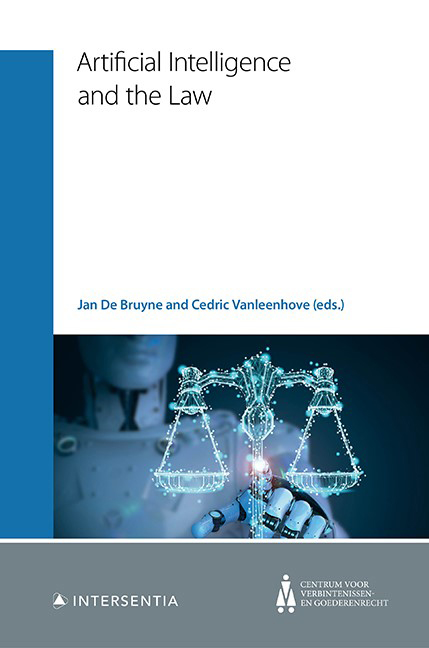Book contents
- Frontmatter
- Contents
- Foreword
- Contributing Authors
- Chapter 1 Basic Concepts of AI for Legal Scholars
- Chapter 2 Different Models of Innovation and Their Relation to Law
- Chapter 3 Setting the Scene: On AI Ethics and Regulation
- Chapter 4 Quantitative Legal Prediction: the Future of Dispute Resolution?
- Chapter 5 AI Arbitrators … ‘Does Not Compute’
- Chapter 6 AI through a Human Rights Lens. The Role of Human Rights in Fulfilling AI’s Potential
- Chapter 7 Killer Robots: Lethal Autonomous Weapons and International Law
- Chapter 8 AI and Data Protection: the Case of Smart Home Assistants
- Chapter 9 AI and IP: a Tale of Two Acronyms
- Chapter 10 Tax and Robots
- Chapter 11 Robotisation and Labour Law. The Dark Factory: the Dark Side of Work?
- Chapter 12 The Hypothesis of Technological Unemployment Caused by AI-Driven Automation and its Impact on Social Security Law
- Chapter 13 AI in Belgian Contract Law: Disruptive Challenge or Business as Usual?
- Chapter 14 Tort Law and Damage Caused by AI Systems
- Chapter 15 Insurance Underwriting on the Basis of Telematics: Segmentation and Profiling
- Chapter 16 AI and Creditworthiness Assessments: the Tale of Credit Scoring and Consumer Protection. A Story with a Happy Ending?
- Chapter 17 AI and the Consumer
- Chapter 18 Robots and AI in the Healthcare Sector: Potential Existing Legal Safeguards Against a(n) (Un)justified Fear for ‘Dehumanisation’ of the Physician-Patient Relationship
Chapter 9 - AI and IP: a Tale of Two Acronyms
Published online by Cambridge University Press: 26 May 2021
- Frontmatter
- Contents
- Foreword
- Contributing Authors
- Chapter 1 Basic Concepts of AI for Legal Scholars
- Chapter 2 Different Models of Innovation and Their Relation to Law
- Chapter 3 Setting the Scene: On AI Ethics and Regulation
- Chapter 4 Quantitative Legal Prediction: the Future of Dispute Resolution?
- Chapter 5 AI Arbitrators … ‘Does Not Compute’
- Chapter 6 AI through a Human Rights Lens. The Role of Human Rights in Fulfilling AI’s Potential
- Chapter 7 Killer Robots: Lethal Autonomous Weapons and International Law
- Chapter 8 AI and Data Protection: the Case of Smart Home Assistants
- Chapter 9 AI and IP: a Tale of Two Acronyms
- Chapter 10 Tax and Robots
- Chapter 11 Robotisation and Labour Law. The Dark Factory: the Dark Side of Work?
- Chapter 12 The Hypothesis of Technological Unemployment Caused by AI-Driven Automation and its Impact on Social Security Law
- Chapter 13 AI in Belgian Contract Law: Disruptive Challenge or Business as Usual?
- Chapter 14 Tort Law and Damage Caused by AI Systems
- Chapter 15 Insurance Underwriting on the Basis of Telematics: Segmentation and Profiling
- Chapter 16 AI and Creditworthiness Assessments: the Tale of Credit Scoring and Consumer Protection. A Story with a Happy Ending?
- Chapter 17 AI and the Consumer
- Chapter 18 Robots and AI in the Healthcare Sector: Potential Existing Legal Safeguards Against a(n) (Un)justified Fear for ‘Dehumanisation’ of the Physician-Patient Relationship
Summary
INTRODUCTION
1. In a way, it is currently ‘the best of times’. While some aspects of our present-day society could definitely be characterised as ‘the worst of times’, technological innovations have revolutionised our way of living and have changed many things for the better. It is simultaneously the epoch of belief and incredulity, where we revel at machines that are seemingly able to create artistic works and, even, invent. The interface of AI and intellectual property (IP) law is readily apparent and the possible topics of this chapter are manifold. This chapter provides a bird’s-eye view of the current status of research into some of the relevant legal issues from a primarily EU, civil law perspective. The present extensive introduction further delineates the topic (part 1). It includes a brief analysis of the possible uses of AI as a tool in the IP sector as well a detour along the essentials of IP law. The two-pronged substantive body of the chapter analyses the main legal challenges raised by AI – primarily machine learning AI – in an IP context. First, focus lies with the IP protection of AI technology under patent law and copyright law (part 2). Subsequently, attention shifts to the IP protection of output generated through or by an AI system (part 3). Could such output be susceptible to IP protection under copyright and/or patent law? If this is not the case, should it, and, if so, who could or should own the rights, and what should the modalities of protection be? Without providing the final answer to these questions, the conclusions of this chapter (part 4) caution against unreservedly tearing down the foundations of IP protection for the mere sake of additional incentive creation.
2. AI is a multidimensional, evolving concept with different possible definitions, as explained in chapter 1, part 2 of this book. In this chapter, we will look at AI as the science and engineering of ‘making intelligent machines’, of ‘making computers do things that require intelligence when done by humans’. However, AI algorithms do not function in the same way as the human brain does – in other words, computers do not ‘think’ as we humans do.
- Type
- Chapter
- Information
- Artificial Intelligence and the Law , pp. 207 - 240Publisher: IntersentiaPrint publication year: 2021
- 1
- Cited by

